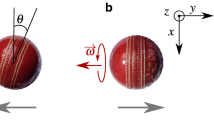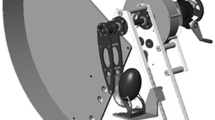Abstract
The aerodynamic properties of a cricket ball have intrigued cricket players and spectators for years, arguably since the advent of the game itself. The main interest is in the fact that the ball can follow a curved flight path that may not always be under the control of the bowler. The basic aerodynamic principles responsible for the nonlinear flight or ‘swing’ of a cricket ball were identified decades ago and many papers have been published on the subject. Over the last 25 years or so, several empirical investigations have also been conducted on cricket ball swing, which revealed the amount of attainable swing and identified the parameters that affect it. Those findings are reviewed here with emphasis on phenomena such as late swing and the effects of humidity on swing. The relatively new concept of ‘reverse swing’, how it can be achieved in practice, and the role in it of ‘ball tampering’, are also discussed in detail. In particular, the ability of some bowlers to effectively swing an old ball in the conventional, reverse and the newly termed ‘contrast’ swing mode is addressed. A discussion of the ‘white” cricket ball used in the 1999 and 2003 World Cup tournaments, which supposedly possesses different swing properties compared to a conventional red ball, is also included. This is a current overview of cricket ball swing rather than a detailed review of all research work performed on the topic. The emphasis is on presenting scientific explanations for the various aerodynamic phenomena that affect cricket ball swing on a cricket ground.
Similar content being viewed by others
References
Barton, N.G. (1982) On the swing of a cricket ball in flight.Proc. Roy. Soc. Lond. A,379, 109–131.
Bentley, K., Varty, P., Proudlove, M. & Mehta, R.D. (1982)An experimental study of cricket ball swing. Imperial College Aero Technical Note, 82–106.
Binnie, A.M. (1976) The effect of humidity on the swing of cricket balls.Int. J. Meck Sci,18, 497–9.
Bown, W. & Mehta, R.D. (1993) The seamy side of swing bowling.New Scientist,139 (1887), 21–24.
Bowen, L.O. (1997) Torque and force measurements on a cricket ball and the influence of atmospheric conditions.Trans. Mech. Eng. IE Australian,ME20 (1), 15–20.
Cooke, J.C. (1955) The boundary layer and seam bowling.The Mathematical Gazette,39, 196–199.
Grant, C., Anderson, A. & Anderson, J.M. (1998) Cricket ball swing — the Cooke-Lyttleton theory revisited. In: S.J. Haake (Ed.)The Engineering of Sport — Design and Development, Blackwell Publishing, Oxford, pp. 371–378.
Horlock, J.H. (1973)The swing of a cricket ball. ASME Symposium on the Mechanics of Sport.
Imbrosciano, A. (1981)The swing of a cricket ball. Project Report. Newcastle College of Advanced Education, Newcastle, Australia.
Lyttleton, R.A. (1957) The swing of a cricket ball.Discovery,18, 186–191.
Mehta, R.D. and Wood, D.H. (1980) Aerodynamics of the cricket ball.New Scientist,87 (1213), 442–447.
Mehta, R.D., Bentley, K., Proudlove, M. & Varty, P. (1983) Factors affecting cricket ball swing.Nature,303, 787–88.
Mehta, R.D. (1985) Aerodynamics of sports balls.Annual Review of Fluid Mechanics,17, 151–189.
Mehta, R.D. (2000) Cricket Ball Aerodynamics: Myth Versus Science. In: A.J. Subic and S J. Haake (Eds.)The Engineering of Sport — Research, Development and Innovation. Blackwell Science, London, pp. 153–167.
Newton, I. (1672) New theory of light and colours.Phil. Trans. R. Soc.,1, 678–688.
Oslear, D. & Bannister, J. (1996)Tampering with Cricket. Collins Willow (Harper Collins) Publishers, London.
Penrose, J.M.T., Hose, D.R. & Trowbridge, E.A. (1996) Cricket ball swing: a preliminary analysis using computational fluid dynamics. In: S.J. Haake (Ed.)The Engineering of Sport. A.A. Balkema, Rotterdam, pp. 11–19.
Rayleigh, Lord (1877) On the irregular flight of a tennis ball.Messenger of Mathematics,7, 14–16.
Sayers, A.T. & Hill, A. (1999) Aerodynamics of a cricket ball.J Wind Engineering & Industrial Aerodynamics,79, 169–182.
Sherwin, K. and Sproston, J.L. (1982) Aerodynamics of a cricket ball.Int. J. Mech. Educ.,10, 71–79.
Wilkins, B. (1991)The Bowler’s Art. A & C Black Publishers, London.
Author information
Authors and Affiliations
Corresponding author
Rights and permissions
About this article
Cite this article
Mehta, R.D. An overview of cricket ball swing. Sports Eng 8, 181–192 (2005). https://doi.org/10.1007/BF02844161
Issue Date:
DOI: https://doi.org/10.1007/BF02844161




